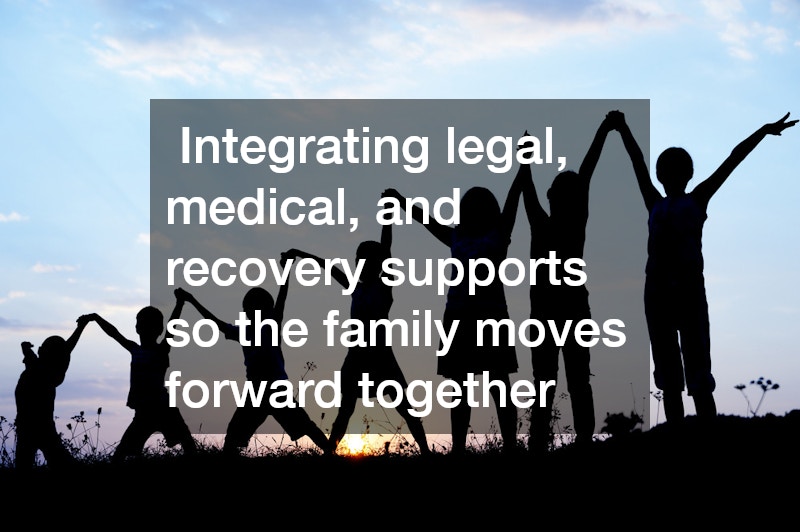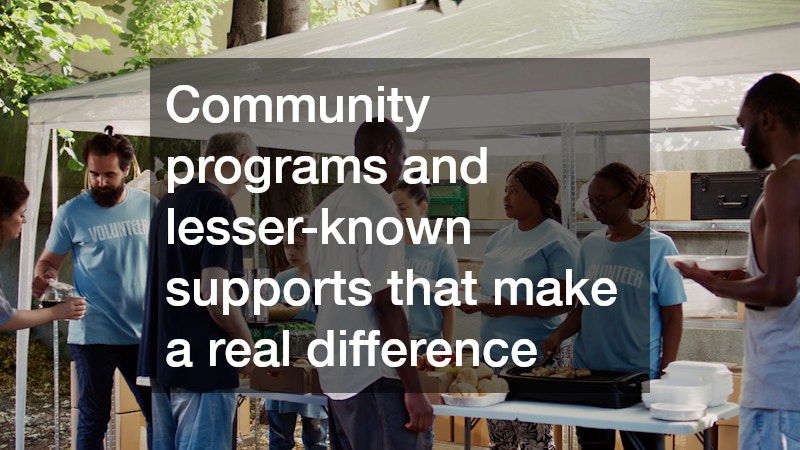
Life rarely follows a script. Jobs change, relationships strain, health problems appear out of nowhere, and legal or financial emergencies can arrive with little warning. When pressures pile up, knowing who to call, which questions to ask, and how to prioritize needs can make the difference between chaos and recovery. This guide gathers practical advice about community, medical, legal, and social resources that help families regain stability. Instead of a strict checklist, it focuses on human-centered strategies—how to evaluate options, reduce stress for loved ones, and protect what matters most.
Below are clear explanations, concrete tips, and quick-reference bullets organized by type of crisis. Use the sections that match your situation and bookmark the page for later. The goal is to help you act with intention, compassion, and confidence. No family can prevent every crisis, but with preparation, communication, and access to trusted resources, you can transform emergencies into manageable challenges and safeguard your family’s stability.
When legal trouble hits home: protecting your family quickly and wisely
A sudden arrest or criminal charge can feel like everything is falling apart — shock, fear for the detained person’s safety, and urgent questions about release. The initial moments and decisions matter.
Start by gathering facts: detention location, booking number, and alleged charges. With that you can evaluate options—posting bail, requesting a hearing, or working with counsel to seek release without bail.
Key considerations and realistic tips:
-
Ask for written estimates. Whether dealing with a surety bail bond service or interviewing criminal defense attorneys, request written fee breakdowns and any collateral terms.
-
Verify credentials. For attorneys, check your state bar; for bond agents, confirm licensing with the appropriate state regulator.
-
Understand timelines. Posting bond can secure release quickly but won’t resolve the case. A good criminal defense attorney explains plea options, diversion programs, and defense strategies.
-
Protect family finances. If collateral is required, weigh long-term implications. Sometimes negotiating a bail reduction or seeking alternative release is preferable.
-
Make a communication plan. Designate one person to relay information to relatives and professionals to reduce duplication and confusion.
Practical checklist:
-
Collect detention details (location, booking number).
-
Verify bond agent and attorney credentials.
-
Compare written fee quotes and collateral terms.
-
Ask attorneys about likely outcomes and timelines in the first consultation.
Act fast to secure release when possible, but invest time in choosing representation that will protect long-term interests.
Handling medical crises and deeper health concerns without panic
Medical emergencies require immediate action and, often, a longer recovery plan. Knowing how to navigate both urgent and ongoing care minimizes errors and emotional overload.
Acute emergencies:
-
Keep a succinct medical card in every family member’s wallet or phone: name, primary care number, allergies, key conditions, and insurance info.
-
Know the nearest trusted emergency hospital and a secondary option with specialized services (trauma, pediatric, stroke).
-
Bring medications, recent test results, and a list of treating physicians when going to the ER. Have a designated family member relay history and decisions.
Chronic and behavioral health:
-
If a loved one shows signs of substance dependence—declining functioning, legal problems, or health deterioration—research accredited programs early. An addiction treatment center should use evidence-based care, offer family involvement, and provide clear aftercare planning.
-
Compare programs on length of stay, therapy models (CBT, MAT), family counseling availability, relapse prevention, and insurance acceptance. Ask for accreditation and program outcomes.
-
After an ER visit for overdose or related crises, insist on a warm handoff to outpatient or residential care. Hospitals that coordinate with treatment programs reduce immediate relapse risk.
Practical considerations:
-
Know your insurance benefits: emergency coverage, inpatient care, and behavioral health services and any pre-authorizations required.
-
Prepare emotionally: family members often feel guilt, anger, or denial. Seek trusted counselors or support groups to process decisions alongside medical professionals.
-
Ask programs about family education sessions. Those that teach how to set boundaries and support recovery reduce long-term strain.
Combining fast ER action with thoughtful selection of continuing care improves both immediate survival and long-term recovery prospects.
Safeguarding your home and financial future when money gets tight
Financial stress can cascade into housing instability and legal complications. Before panic sets in, pragmatic steps can materially improve outcomes.
Immediate triage:
-
Contact your mortgage servicer early. Lenders often prefer loss mitigation—temporary forbearance, loan modification, or repayment plans—over foreclosure.
-
Consult a foreclosure attorney when lender communications stall or you receive official notices. An attorney can explain timelines, challenge deficient notices, and negotiate alternatives.
Protecting household stability:
-
Document everything: copies of correspondence, payment records, and notes of phone calls (date, time, representative).
-
Understand family law implications. If separation, divorce, or dispute is part of the picture, consult a family law attorney to learn how debts and property may be handled.
-
Prioritize essentials: housing, utilities, food, and medical needs. Create a short-term budget focused on survival while exploring long-term fixes.
Helpful resources:
-
Nonprofit credit counseling can mediate with lenders and craft a realistic monthly plan.
-
Community legal aid often provides free or sliding-scale consultations for homeowners facing foreclosure.
-
If separation is imminent, ask a family law practitioner about temporary orders that prevent unilateral removal of funds or property.
What to discuss with a foreclosure attorney:
-
Loan status (current, delinquent, default).
-
Possible defenses (servicing errors, incorrect accounting).
-
Options: modification, deed-in-lieu, short sale, bankruptcy implications.
-
Timing and deadlines you must meet.
Thoughtful handling preserves housing where possible and reduces long-term harm to credit and family relationships.
Supporting children through upheaval, schooling, and care transitions
Children sense disruption even when adults shield them. The most valuable things you can provide are routine, clear explanations, and age-appropriate support that helps them feel secure.
Care and routine:
-
If work and family changes require childcare, prioritize options that balance cost and quality. Affordable child care can be found via community centers, subsidies, and employer benefits. Check staff-to-child ratios, licensing, and caregiver approaches to transitions.
-
Consider flexible scheduling or co-op models where families swap hours to reduce costs while keeping routines predictable.
When adoption or expanded family structures are involved:
-
Research adoption agencies carefully: accreditation, transparent fees, post-placement support, and clear timelines are essential.
-
Pre-placement counseling and post-placement resources that focus on attachment help families form stable bonds.
Helping children adapt:
-
Keep communication simple and honest. Emphasize what will remain consistent: bedtime routines, who will care for them, and reassuring rituals.
-
Watch for signs of distress—changes in sleep, appetite, school performance, or behavior—and seek early support from school counselors or pediatric mental health professionals.
Practical tips for choosing affordable child care:
-
Ask other parents for references.
-
Confirm licensing and background checks.
-
Observe drop-off and pick-up routines for safety and mood.
-
Investigate subsidies or sliding-scale options from local nonprofits.
Whether temporary support or life-changing adoption is involved, families do best when practical screening is paired with emotional preparation and ongoing support.
Caring for aging relatives while protecting family wellbeing
When an elderly relative needs more help, families juggle logistics, finances, and the emotional shift from independence to assistance. Choosing the right living arrangement and maintaining healthy caregiver relationships matters.
Assessing living options:
-
Visit multiple local assisted living facility choices. Note cleanliness, staff interactions, activities, menus, and how medication and health changes are handled.
-
Ask about care plans and staffing ratios. High turnover or poor medication protocols are red flags.
-
Consider proximity to family; frequent visits reduce isolation and support wellbeing.
Emotional strain and relationship care:
-
Caregiving can magnify stress and surface long-buried conflicts. Couples sharing duties may experience resentment or burnout.
-
Local marriage therapists with experience in caregiver stress can help couples navigate role changes and preserve relationships.
Practical caregiver strategies:
-
Build a rotating schedule so no one person bears full responsibility. Scheduled breaks reduce burnout.
-
Use an external care manager for a neutral assessment and coordination of services.
-
Ensure legal and financial documents (power of attorney, advance directives) are in place to avoid emergency court interventions.
What to ask on a facility tour:
-
Staff-to-resident ratio per shift?
-
How is medication administered and monitored?
-
What is staff turnover like?
-
Are family members invited to care conferences and activities?
Choosing the right setting and addressing relational fallout with professional help preserves dignity and prevents crisis.
Integrating legal, medical, and recovery supports so the family moves forward together
Sustained recovery happens when services work together. Families often need legal guidance, medical follow-up, and addiction recovery resources simultaneously—coordination reduces relapse risk and legal escalation.
How to coordinate care:
-
Centralize records and contacts. Keep a secure folder—digital or physical—containing legal documents, treatment plans, court dates, and key medical notes. Share access with trusted family members or professionals.
-
Invite cross-communication. With permission, enable the family law attorney, primary care provider, and the addiction treatment center to exchange essential information so decisions reflect the whole picture.
-
Plan realistic reintegration. After an addiction treatment center program, immediate demands can overwhelm someone in recovery. Establish phased re-entry with manageable responsibilities and a clear relapse-prevention plan.
Supports that reduce friction:
-
Use court-approved diversion or treatment-first options where possible; family law professionals can guide toward rehabilitation-focused solutions.
-
Secure local supports for day-to-day needs: transportation to appointments, reliable childcare, and stable housing arrangements.
-
Encourage family education about addiction so members can set supportive boundaries without enabling harmful behaviors.
Coordination and clear boundaries make recovery and legal compliance practical and sustainable.
Preparing a living resource plan that saves time and reduces panic
Preparing a living resource plan isn’t about expecting the worst; it’s about making smart calls when time is short.
What to include:
-
A short list of vetted professionals: a foreclosure attorney, a reliable surety bail bond service, a criminal defense contact, and a family law resource—with phone numbers, addresses, and notes about fees or sliding scales.
-
A brief family medical and legal record: insurance IDs, doctor contacts, recent diagnoses, and power-of-attorney or advance directives.
-
A small emergency fund for legal or housing crises—even a few hundred dollars can buy crucial time.
How to maintain it:
-
Review the plan twice a year and after major life changes (new job, move, birth, or loss).
-
Share it with at least two trusted relatives so knowledge isn’t siloed.
-
Store physical copies securely and encrypted digital copies accessible remotely.
Quick action items:
-
Compile contact list with notes on when to call each professional.
-
Photograph and store key documents digitally.
-
Establish a primary family communicator and a backup.
A living resource plan takes little effort and pays dividends when stress is high.
Community programs and lesser-known supports that make a real difference
Communities offer many resources families often overlook: sliding-scale clinics, school counselors, child-care co-ops, and assisted living facility outreach programs providing respite.
Where to look:
-
Local government pages list subsidized child care and affordable child care programs that accept vouchers or offer income-based discounts.
-
Area Agencies on Aging and aging services departments maintain directories for local assisted living facility options and caregiver supports.
-
Nonprofits and faith-based groups frequently run emergency funds, clothing closets, and transitional housing resources.
Evaluating community offers:
-
Ask for references and success stories; local programs with strong ties will connect you to families who’ve benefited.
-
Check eligibility early; many programs have strict income or residency rules.
-
Combine supports: a community center may provide childcare while nonprofits help with temporary rent assistance.
Short resource-finding checklist:
-
Search county or city human services pages.
-
Call school counselors for family referrals.
-
Contact aging networks for assisted living directories and respite supports.
Leveraging community programs can lower costs, provide emotional support, and create durable connections.
When life gets overwhelming, the most stabilizing thing a family can do is act from preparation, informed judgment, and mutual care. The right mix of medical attention, legal counsel, community services, and emotional support will look different for every household, but the principles are the same: document clearly, verify credentials, prioritize safety, and share the burden so no one person collapses under responsibility.
Keep a living resource plan with trusted contacts, keep communication open within your family, and reach out for professional help before problems become entrenched. Small, deliberate actions—choosing the right provider, keeping records, and leaning on community supports—turn chaotic emergencies into recoverable events. Families aren’t defined by the crises they face, but by how they come together afterward.
Life rarely follows a script. Jobs change, relationships strain, health problems appear out of nowhere, and legal or financial emergencies can arrive with little warning. When pressures pile up, knowing who to call, which questions to ask, and how to prioritize needs can make the difference between chaos and recovery. This guide gathers practical advice about community, medical, legal, and social resources that help families regain stability. Instead of a strict checklist, it focuses on human-centered strategies—how to evaluate options, reduce stress for loved ones, and protect what matters most.
Below are clear explanations, concrete tips, and quick-reference bullets organized by type of crisis. Use the sections that match your situation and bookmark the page for later. The goal is to help you act with intention, compassion, and confidence. No family can prevent every crisis, but with preparation, communication, and access to trusted resources, you can transform emergencies into manageable challenges and safeguard your family’s stability.
When legal trouble hits home: protecting your family quickly and wisely
A sudden arrest or criminal charge can feel like everything is falling apart — shock, fear for the detained person’s safety, and urgent questions about release. The initial moments and decisions matter.
Start by gathering facts: detention location, booking number, and alleged charges. With that you can evaluate options—posting bail, requesting a hearing, or working with counsel to seek release without bail.
Key considerations and realistic tips:
-
Ask for written estimates. Whether dealing with a surety bail bond service or interviewing criminal defense attorneys, request written fee breakdowns and any collateral terms.
-
Verify credentials. For attorneys, check your state bar; for bond agents, confirm licensing with the appropriate state regulator.
-
Understand timelines. Posting bond can secure release quickly but won’t resolve the case. A good criminal defense attorney explains plea options, diversion programs, and defense strategies.
-
Protect family finances. If collateral is required, weigh long-term implications. Sometimes negotiating a bail reduction or seeking alternative release is preferable.
-
Make a communication plan. Designate one person to relay information to relatives and professionals to reduce duplication and confusion.
Practical checklist:
-
Collect detention details (location, booking number).
-
Verify bond agent and attorney credentials.
-
Compare written fee quotes and collateral terms.
-
Ask attorneys about likely outcomes and timelines in the first consultation.
Act fast to secure release when possible, but invest time in choosing representation that will protect long-term interests.
Handling medical crises and deeper health concerns without panic

Medical emergencies require immediate action and, often, a longer recovery plan. Knowing how to navigate both urgent and ongoing care minimizes errors and emotional overload.
Acute emergencies:
-
Keep a succinct medical card in every family member’s wallet or phone: name, primary care number, allergies, key conditions, and insurance info.
-
Know the nearest trusted emergency hospital and a secondary option with specialized services (trauma, pediatric, stroke).
-
Bring medications, recent test results, and a list of treating physicians when going to the ER. Have a designated family member relay history and decisions.
Chronic and behavioral health:
-
If a loved one shows signs of substance dependence—declining functioning, legal problems, or health deterioration—research accredited programs early. An addiction treatment center should use evidence-based care, offer family involvement, and provide clear aftercare planning.
-
Compare programs on length of stay, therapy models (CBT, MAT), family counseling availability, relapse prevention, and insurance acceptance. Ask for accreditation and program outcomes.
-
After an ER visit for overdose or related crises, insist on a warm handoff to outpatient or residential care. Hospitals that coordinate with treatment programs reduce immediate relapse risk.
Practical considerations:
-
Know your insurance benefits: emergency coverage, inpatient care, and behavioral health services and any pre-authorizations required.
-
Prepare emotionally: family members often feel guilt, anger, or denial. Seek trusted counselors or support groups to process decisions alongside medical professionals.
-
Ask programs about family education sessions. Those that teach how to set boundaries and support recovery reduce long-term strain.
Combining fast ER action with thoughtful selection of continuing care improves both immediate survival and long-term recovery prospects.
Safeguarding your home and financial future when money gets tight
Financial stress can cascade into housing instability and legal complications. Before panic sets in, pragmatic steps can materially improve outcomes.
Immediate triage:
-
Contact your mortgage servicer early. Lenders often prefer loss mitigation—temporary forbearance, loan modification, or repayment plans—over foreclosure.
-
Consult a foreclosure attorney when lender communications stall or you receive official notices. An attorney can explain timelines, challenge deficient notices, and negotiate alternatives.
Protecting household stability:
-
Document everything: copies of correspondence, payment records, and notes of phone calls (date, time, representative).
-
Understand family law implications. If separation, divorce, or dispute is part of the picture, consult a family law attorney to learn how debts and property may be handled.
-
Prioritize essentials: housing, utilities, food, and medical needs. Create a short-term budget focused on survival while exploring long-term fixes.
Helpful resources:
-
Nonprofit credit counseling can mediate with lenders and craft a realistic monthly plan.
-
Community legal aid often provides free or sliding-scale consultations for homeowners facing foreclosure.
-
If separation is imminent, ask a family law practitioner about temporary orders that prevent unilateral removal of funds or property.
What to discuss with a foreclosure attorney:
-
Loan status (current, delinquent, default).
-
Possible defenses (servicing errors, incorrect accounting).
-
Options: modification, deed-in-lieu, short sale, bankruptcy implications.
-
Timing and deadlines you must meet.
Thoughtful handling preserves housing where possible and reduces long-term harm to credit and family relationships.
Supporting children through upheaval, schooling, and care transitions

Children sense disruption even when adults shield them. The most valuable things you can provide are routine, clear explanations, and age-appropriate support that helps them feel secure.
Care and routine:
-
If work and family changes require childcare, prioritize options that balance cost and quality. Affordable child care can be found via community centers, subsidies, and employer benefits. Check staff-to-child ratios, licensing, and caregiver approaches to transitions.
-
Consider flexible scheduling or co-op models where families swap hours to reduce costs while keeping routines predictable.
When adoption or expanded family structures are involved:
-
Research adoption agencies carefully: accreditation, transparent fees, post-placement support, and clear timelines are essential.
-
Pre-placement counseling and post-placement resources that focus on attachment help families form stable bonds.
Helping children adapt:
-
Keep communication simple and honest. Emphasize what will remain consistent: bedtime routines, who will care for them, and reassuring rituals.
-
Watch for signs of distress—changes in sleep, appetite, school performance, or behavior—and seek early support from school counselors or pediatric mental health professionals.
Practical tips for choosing affordable child care:
-
Ask other parents for references.
-
Confirm licensing and background checks.
-
Observe drop-off and pick-up routines for safety and mood.
-
Investigate subsidies or sliding-scale options from local nonprofits.
Whether temporary support or life-changing adoption is involved, families do best when practical screening is paired with emotional preparation and ongoing support.
Caring for aging relatives while protecting family wellbeing
When an elderly relative needs more help, families juggle logistics, finances, and the emotional shift from independence to assistance. Choosing the right living arrangement and maintaining healthy caregiver relationships matters.
Assessing living options:
-
Visit multiple local assisted living facility choices. Note cleanliness, staff interactions, activities, menus, and how medication and health changes are handled.
-
Ask about care plans and staffing ratios. High turnover or poor medication protocols are red flags.
-
Consider proximity to family; frequent visits reduce isolation and support wellbeing.
Emotional strain and relationship care:
-
Caregiving can magnify stress and surface long-buried conflicts. Couples sharing duties may experience resentment or burnout.
-
Local marriage therapists with experience in caregiver stress can help couples navigate role changes and preserve relationships.
Practical caregiver strategies:
-
Build a rotating schedule so no one person bears full responsibility. Scheduled breaks reduce burnout.
-
Use an external care manager for a neutral assessment and coordination of services.
-
Ensure legal and financial documents (power of attorney, advance directives) are in place to avoid emergency court interventions.
What to ask on a facility tour:
-
Staff-to-resident ratio per shift?
-
How is medication administered and monitored?
-
What is staff turnover like?
-
Are family members invited to care conferences and activities?
Choosing the right setting and addressing relational fallout with professional help preserves dignity and prevents crisis.
Integrating legal, medical, and recovery supports so the family moves forward together

Sustained recovery happens when services work together. Families often need legal guidance, medical follow-up, and addiction recovery resources simultaneously—coordination reduces relapse risk and legal escalation.
How to coordinate care:
-
Centralize records and contacts. Keep a secure folder—digital or physical—containing legal documents, treatment plans, court dates, and key medical notes. Share access with trusted family members or professionals.
-
Invite cross-communication. With permission, enable the family law attorney, primary care provider, and the addiction treatment center to exchange essential information so decisions reflect the whole picture.
-
Plan realistic reintegration. After an addiction treatment center program, immediate demands can overwhelm someone in recovery. Establish phased re-entry with manageable responsibilities and a clear relapse-prevention plan.
Supports that reduce friction:
-
Use court-approved diversion or treatment-first options where possible; family law professionals can guide toward rehabilitation-focused solutions.
-
Secure local supports for day-to-day needs: transportation to appointments, reliable childcare, and stable housing arrangements.
-
Encourage family education about addiction so members can set supportive boundaries without enabling harmful behaviors.
Coordination and clear boundaries make recovery and legal compliance practical and sustainable.
Preparing a living resource plan that saves time and reduces panic
Preparing a living resource plan isn’t about expecting the worst; it’s about making smart calls when time is short.
What to include:
-
A short list of vetted professionals: a foreclosure attorney, a reliable surety bail bond service, a criminal defense contact, and a family law resource—with phone numbers, addresses, and notes about fees or sliding scales.
-
A brief family medical and legal record: insurance IDs, doctor contacts, recent diagnoses, and power-of-attorney or advance directives.
-
A small emergency fund for legal or housing crises—even a few hundred dollars can buy crucial time.
How to maintain it:
-
Review the plan twice a year and after major life changes (new job, move, birth, or loss).
-
Share it with at least two trusted relatives so knowledge isn’t siloed.
-
Store physical copies securely and encrypted digital copies accessible remotely.
Quick action items:
-
Compile contact list with notes on when to call each professional.
-
Photograph and store key documents digitally.
-
Establish a primary family communicator and a backup.
A living resource plan takes little effort and pays dividends when stress is high.
Community programs and lesser-known supports that make a real difference

Communities offer many resources families often overlook: sliding-scale clinics, school counselors, child-care co-ops, and assisted living facility outreach programs providing respite.
Where to look:
-
Local government pages list subsidized child care and affordable child care programs that accept vouchers or offer income-based discounts.
-
Area Agencies on Aging and aging services departments maintain directories for local assisted living facility options and caregiver supports.
-
Nonprofits and faith-based groups frequently run emergency funds, clothing closets, and transitional housing resources.
Evaluating community offers:
-
Ask for references and success stories; local programs with strong ties will connect you to families who’ve benefited.
-
Check eligibility early; many programs have strict income or residency rules.
-
Combine supports: a community center may provide childcare while nonprofits help with temporary rent assistance.
Short resource-finding checklist:
-
Search county or city human services pages.
-
Call school counselors for family referrals.
-
Contact aging networks for assisted living directories and respite supports.
Leveraging community programs can lower costs, provide emotional support, and create durable connections.
When life gets overwhelming, the most stabilizing thing a family can do is act from preparation, informed judgment, and mutual care. The right mix of medical attention, legal counsel, community services, and emotional support will look different for every household, but the principles are the same: document clearly, verify credentials, prioritize safety, and share the burden so no one person collapses under responsibility.
Keep a living resource plan with trusted contacts, keep communication open within your family, and reach out for professional help before problems become entrenched. Small, deliberate actions—choosing the right provider, keeping records, and leaning on community supports—turn chaotic emergencies into recoverable events. Families aren’t defined by the crises they face, but by how they come together afterward.
